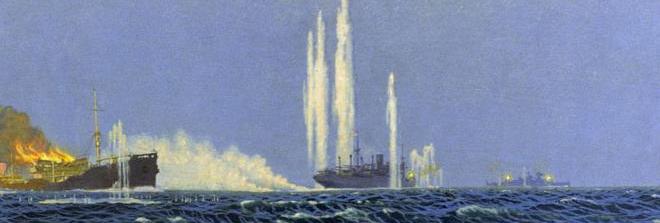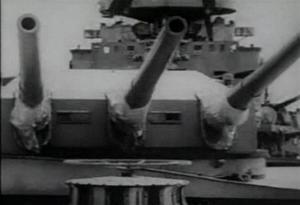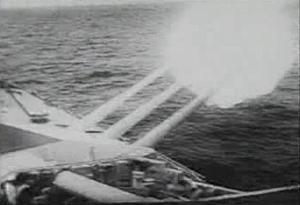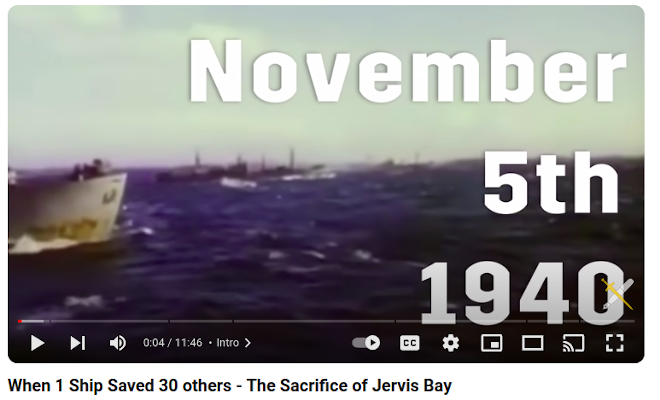
In November 1940 the Jervis Bay was the sole
escort for Convoy HX84 of thirty-seven freighters and tankers moving from Halifax to
Britain. See the
Order of Battle here.


Earlier, the German "pocket battleship"
Admiral
Scheer had slipped quietly into the Atlantic. She located the Jervis
Bay's convoy and decided to attack immediately, as it was late afternoon
and it would be difficult to find targets in the dark. Captain Fegen of the
Jervis Bay decided to advance to meet the raider, in the hope of
delaying the Germans long enough to enable most of the convoy to escape. The
convoy was ordered to scatter and the Jervis Bay, dropping smoke floats
as she went, endeavoured to bring the Admiral Scheer within the range of
her guns. |
 |
 |
|

In this latter aim she never succeeded. Although
her guns
fired often, every shot fell short of the enemy. A seaman who watched the
outmatched merchantman throw everything but its boiler plates at the Admiral
Scheer said it was like a bulldog attacking a bear. Meanwhile
11-inch shells
from the raider began to hit. The crew had little protection from blast or
from splinters, and casualties were heavy.
 |
 |

The bridge was soon hit, and with it the Jervis Bay's gunnery control
centre. Captain Fegen lost an arm and soon afterwards was killed by another
shell. Most of the officers were killed.
Nevertheless, this one-sided battle lasted
for twenty-four minutes. At the end of that period the Jervis Bay
was ablaze and her guns out of action, and the order was given to
abandon ship.
Excerpt from
Fighting
Ships Of World War 2 |
As told by Trevor Skeggs. nephew of Len Baker (AB, RNVR), Killed in Action...
 The position of the convoy
was known to the Germans.
In
his book,
The position of the convoy
was known to the Germans.
In
his book, Kapitän Theodore
Krancke certainly makes no secret of expecting to find convoy HX84.
("That was the convoy all right").
As the Jervis Bay repeatedly signalled the challenge "A",
the signals officer of the Scheer was commanded to attempt a bluff.
" ... 'She'll give her recognition signal in a moment,' said
Krancke. 'Whatever it
turns out to be repeat it at once as though we were calling her.'
Krancke was anxious to leave the enemy in doubt as to his real identity for as
long as possible in order to get close up to the convoy before opening fire. At
the moment the distance between the Scheer and the British auxiliary
cruiser was still about fifteen miles.
The auxiliary cruiser's 'A' was now followed by 'M' - 'A' - 'G' in quick
succession. The Signals Officer of the Scheer immediately had the
'M.A.G' signal repeated, but the bluff failed. The Captain of the British
auxiliary cruiser was not deceived. In any case, he probably knew quite
definitely that no friendly warship could possibly be in that quarter, and now
sheafs of red rockets began to hiss up from his decks - clearly the
pre-arranged signal for the convoy to scatter. At the same time the auxiliary
cruiser and most of the other ships in the convoy began to lay down a smoke
screen.
 The distance between
the two ships was considerably less now and when it was about ten miles the
Scheer, which up to then had been racing straight towards the convoy,
turned to port to bring her broadside to bear. The guns were trained on their
targets now - the
big guns had
been ordered to concentrate on the British auxiliary cruiser while the
medium artillery was to
take a tanker not far away from her as its target.
The distance between
the two ships was considerably less now and when it was about ten miles the
Scheer, which up to then had been racing straight towards the convoy,
turned to port to bring her broadside to bear. The guns were trained on their
targets now - the
big guns had
been ordered to concentrate on the British auxiliary cruiser while the
medium artillery was to
take a tanker not far away from her as its target.
The British auxiliary cruiser, which was ahead of the second line of the
convoy, had stopped signalling, and by this time the ships were close enough
for the British Captain to have realised what he was faced with, for the
outlines of the Scheer were now clearly visible against the evening sky
and he could plainly see the guns of her triple turrets trained on him. As
unlikely as it might seem, he had encountered a German pocket battleship in
mid-Atlantic.
 His
immediate reaction to this knowledge was to put his own ship between the
Scheer and what was obviously a two-funnelled passenger vessel and
probably the most valuable ship in the convoy. It floated far higher in the
water than the other vessels. The Scheer was now less than ten miles
from the nearest ship of the convoy, which was the auxiliary cruiser, and
Krancke ordered his guns to open up. A preliminary salvo screamed off from one
of the turrets to check the range. That was at 16:42 hours. ..."
His
immediate reaction to this knowledge was to put his own ship between the
Scheer and what was obviously a two-funnelled passenger vessel and
probably the most valuable ship in the convoy. It floated far higher in the
water than the other vessels. The Scheer was now less than ten miles
from the nearest ship of the convoy, which was the auxiliary cruiser, and
Krancke ordered his guns to open up. A preliminary salvo screamed off from one
of the turrets to check the range. That was at 16:42 hours. ..."

As is recognised in the muddle of battle, accounts differ. All agree on the
accuracy of the German gunnery. Survivor
Sam Patience had joined HMCS Lincoln as
quartermaster for her Canadian sea trials. He was not impressed, and jumped at
the chance to steer an ocean liner by swapping ships with a quartermaster he'd
met in Halifax who needed to get home in a hurry; the Jervis Bay had to
wait for a convoy.
 Sam was
midway through the first dogwatch on his eighth day at the wheel, when the
unknown ship was spotted at 16:55 on Nov. 5th. (Guy Fawke's day). They had been
anticipating submarines below
Sam was
midway through the first dogwatch on his eighth day at the wheel, when the
unknown ship was spotted at 16:55 on Nov. 5th. (Guy Fawke's day). They had been
anticipating submarines below or
Condors
above
. "The chief
yeoman signalled with the Aldis lamp to the unknown warship. There was no
reply. The crew looked through the eyesights of the guns. They could see the
silhouette plainly. Someone suggested it was an *R-class, friendly
battleship, but Patience explained that it couldn't be because they had a
distinctive 'tiddly-top' on the funnel. They were still speculating when the
first salvo whistled over their heads and exploded in the sea about 100 yards
away. " . . . . . . . . .
"Patience handed the wheel to another sailor and went to man the
forward port gun. The crew were told to throw smoke floats over the side - big
containers like dustbins" . . . . . . "Then the Jervis Bay
steamed to port, away from the smoke and straight towards the Admiral
Scheer. The second salvo fell short, but shrapnel from an exploding shell
decapitated the man standing next to Patience." ..... "The third
salvo caught the Jervis Bay amidships, smashing the wireless office and
much of the deck superstructure. Captain Fegen ordered full speed ahead, and
steered straight towards the enemy. More explosions rocked the liner. Patience
looked up to see the bridge alight and the captain with one arm partly severed.
There were fires everywhere now. Men were on fire, too. Screaming, they jumped
over the side.
The next salvo blew the gun opposite Patience right off the forecastle,
along with its mounting and its crew. The shells arrived at a horrific
velocity. The ship bucked and rolled under the impact. The next one had to kill
him, Patience thought. Instead, its blast blew him off the gun platform and
down the well deck, dazed but only slightly injured".
All subsequent Allied accounts seem to follow the above version: from "The
Lonely Sea" :
"Two ranging salvos fell one on either side of the armed merchant cruiser,
displaying testimony to the German reputation for gunnery of a quite phenomenal
accuracy : the third salvo crashed solidly into the hull. In one stroke the
foremast was shot away, the director and range.finder wrecked, the transmitting
station, which controlled the guns, knocked out of action and the guns
themselves rendered useless for all but primitive hand control - the cables
feeding in the electrical supplies had been completely severed. The battle had
not yet properly begun, but already the Jervis Bay was finished as a fighting
unit.
Kapitän Theodore Krancke of the Admiral Scheer knew that he had
nothing more to fear from the big merchantman. He at once altered course to
overtake the fleeing convoy, only to find that his way was barred once more:
the Jervis Bay, too, had put over her helm, and was closing rapidly on a head-
on collision course." However, the German account does not exploit this
account for propaganda purposes: "Coloured rockets were still shooting
into the air from the deck of the British auxiliary cruiser. They were
different signals. Who were they intented for ? Were they still for the
scattering ships or were they perhaps warning signals to cruiser protection on
the starboard side of the convoy and therefore invisible to the Scheer ?

After a period of
twenty-three seconds, which seemed much longer, the first salvo from the
Scheer fell into the shimmering grey-blue sea, sending up vast fountains
of foamy white water sharply outlined in black at the edges. The shells
exploded between the Scheer and her target, blotting the British cruiser
temporarily from view. That first salvo had not been more than about 200 yards
from its target. A second, corrected salvo now followed from both turrets and
almost simultaneously there were flashes of gunfire from the enemy, but the
spurts of flame visible amidships and aft were small and feeble compared with
the tremendous stabs of flame and the shattering explosions from the guns of
the Scheer. They looked little more than signals, but they showed that
the enemy was returning the fire to the best of his ability and the fact that
the response was so prompt indicated that the British auxiliary cruiser had
been ready for action and that her guns were served by trained naval men. But
the return fire fell much too short, with the exception of a single shell that
fell close enough to send spray onto the deck of the Scheer, and it was
clear either that the British auxiliary cruiser had only one gun with range
enough to get anywher near the Scheer or that she had no central fire
control and in consequence her guns were firing independently." .
 According to the German account, it was the fifth salvo that first
devastatingly hit the Jervis Bay.
According to the German account, it was the fifth salvo that first
devastatingly hit the Jervis Bay.
Contrary to British propaganda, we weren't the only ones with radar.
Kapitän Krancke reveals that the Admiral Scheer was equipped with
radar so secret that only a few of the crew knew about it. The accuracy of the
gunnery is thus explained.




